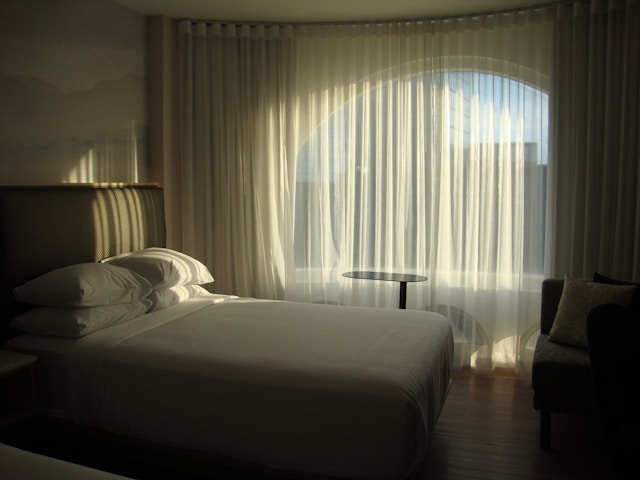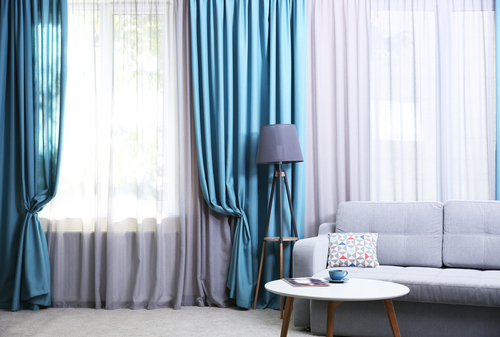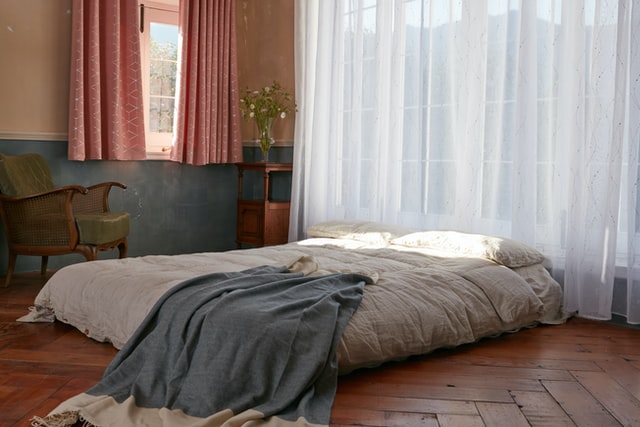Curtaining adds more than a decorative aspect to interior spaces; it is a multi-functional embellishment which serves both practical purposes and improves the overall aesthetic of a room. Curtains are widely used to create different looks within interior spaces, offering more “bang for the buck” than window shades and blinds alone, and they are easily changeable for different seasons or when redecorating, as they are a less expensive and more customisable option in interior design. The choice of curtaining, material design and texture, can instantly impact a room, whether you’re looking to create a cosy atmosphere, regulate natural light, or add a touch of sophistication. To my mind, the keyword in curtaining applications is definitely “versatility”.

What is Curtaining?
Curtaining is the use of fabric or other materials to cover windows, doors, or other openings. This encompasses everything from classic curtains and drapes to blinds and contemporary window treatments. Each type and material fulfils distinct purposes, ranging from enhancing aesthetics to improving energy efficiency and providing privacy.
The Purpose of Curtaining
Curtaining is designed for several purposes, providing valid reasons to invest in this decorative and functional aspect of daily life. Some of these purposes include aspects such as:
- Light Control
One of the primary purposes of curtains is to regulate the amount of natural light entering a room. Options range from sheer fabrics that allow soft filtered light to enter a room to blackout curtains that block sunlight or outside light entirely, making them ideal for bedrooms or media rooms. - Privacy and Security
Curtains create a visual barrier between your space and the outside world, ensuring privacy in urban environments or areas where homes are closely positioned. This is particularly important during those periods when interior lighting is on, making you even more visible from outdoors. I have never liked the idea of being able to be observed by unseen passers-by whose intentions may not be wholly honourable, although some people do not find this worrisome. Curtains do at least provide an option – one way or another. Sheer curtains or netting are popular choices for bedrooms and living areas which directly face the street, allowing light to enter whilst also offering a vital element of privacy. - Temperature and Noise Regulation
Certain types of curtains, such as thermal or insulated, aid in maintaining comfortable indoor temperatures. They reduce heat loss in winter and block out excessive heat in summer, directly resulting in energy savings, and cutting down on the excessive need for cooling fans or heaters. For instance, during the bitterly cold winter months in European countries, it is common for heavy or thermal curtains to be hung over front doors, especially those with glass components, to further aid in conserving heat. Thicker curtains, or those made of a polyester blend with thermal backing, also assist in providing extra noise reduction. Thick acoustic fabrics, such as blackout curtains and studio blankets, are also available for controlling noise (acoustics) in larger rooms or halls and are popular choices for theatre curtains. On a practical level, heavier curtains or those made with soundproofing materials can minimise outside noise, making them an excellent choice for properties on busy streets or sharing spaces. - Room Division
Curtains are sometimes used as partitions to create separate areas in open-plan spaces. This is a cost-effective, convenient and flexible way to change the layout without permanent construction. Curtains are used in hospital wards and doctors’ consultation rooms to provide privacy and a level of soundproofing for patients during physical examinations. This feature is especially important when a family member accompanies the patient to the doctor’s room. - Aesthetic Enhancement
Curtains contribute significantly to the overall aesthetics of a space. They play a vital role in shaping the look and feel of a room. With options ranging from striking patterns and vivid colours to soft textures and muted tones, they can harmoniously bring together various design elements and showcase individual styles.
Choosing the Right Curtains for the Room
Even though they are easily changeable, it is important to select the right curtaining, colour and pattern for your space right from the beginning. Big, bold patterns can easily dominate and make a confined space appear smaller and even claustrophobic, whereas neutral, overly busy or tiny prints can have a displeasing or disconcerting effect in a larger setting, either making the room feel even larger or drawing the eye to the curtains for the wrong reasons.
Various factors should be considered when selecting the right curtains, such as:
- Use of the Space: Blackout curtains may be a good choice in bedrooms, especially for those who cannot sleep in rooms with a lot of light, or in an area where computer screens are difficult to see in bright light. When combined with sheer curtaining or netting, this would provide a private and comfortable space when more light is needed. Living rooms might also benefit from combined options, such as blinds and curtains in different or contrasting patterns which accentuate the general furnishings of the room without dominating the space.
- Window Size and Shape: Custom/bespoke curtains may need to be made for non-standard window dimensions and shapes. In such a case, it would be a wise option to call in a curtaining specialist to assist.
- Aesthetic Appeal: Curtains may seamlessly blend into the existing décor, thus extending the overall visual appeal of a room, or be chosen to provide a contrast in colour or pattern to break neutrality or present a bespoke look – often accompanied by similarly patterned throws or cushions. Whatever the choice, the window coverings should ultimately complement the existing décor. For those seeking professional guidance in selecting the perfect curtains, curtain specialists are an invaluable asset.
- Standard or Bespoke: There are many affordable ready-made curtains available to suit almost any room, but more complex or bespoke requirements can also easily be accommodated by using specialist services.
To Summarise:
Curtains, like any decorative element, should strike the ideal balance between form and function, providing practical advantages while enhancing the visual charm of a space. Whether completely revamping a room or simply refreshing your décor, well-chosen curtains can transform the ambience, increase comfort, and cater to your unique needs. Whatever your intention may be – to make a bold style statement or create a cosy retreat – the right curtains can have a significant impact, so choose carefully and wisely from the start.

